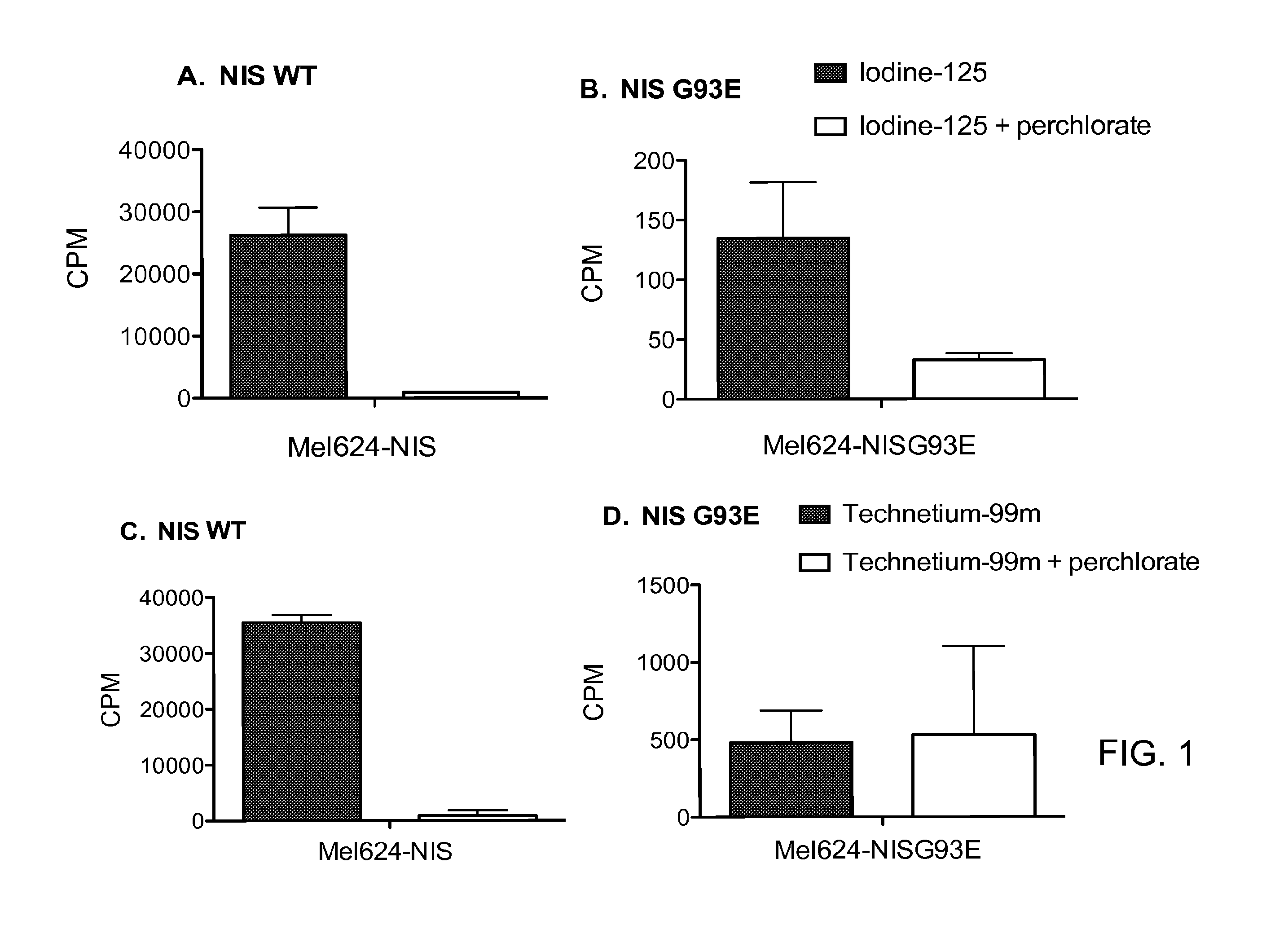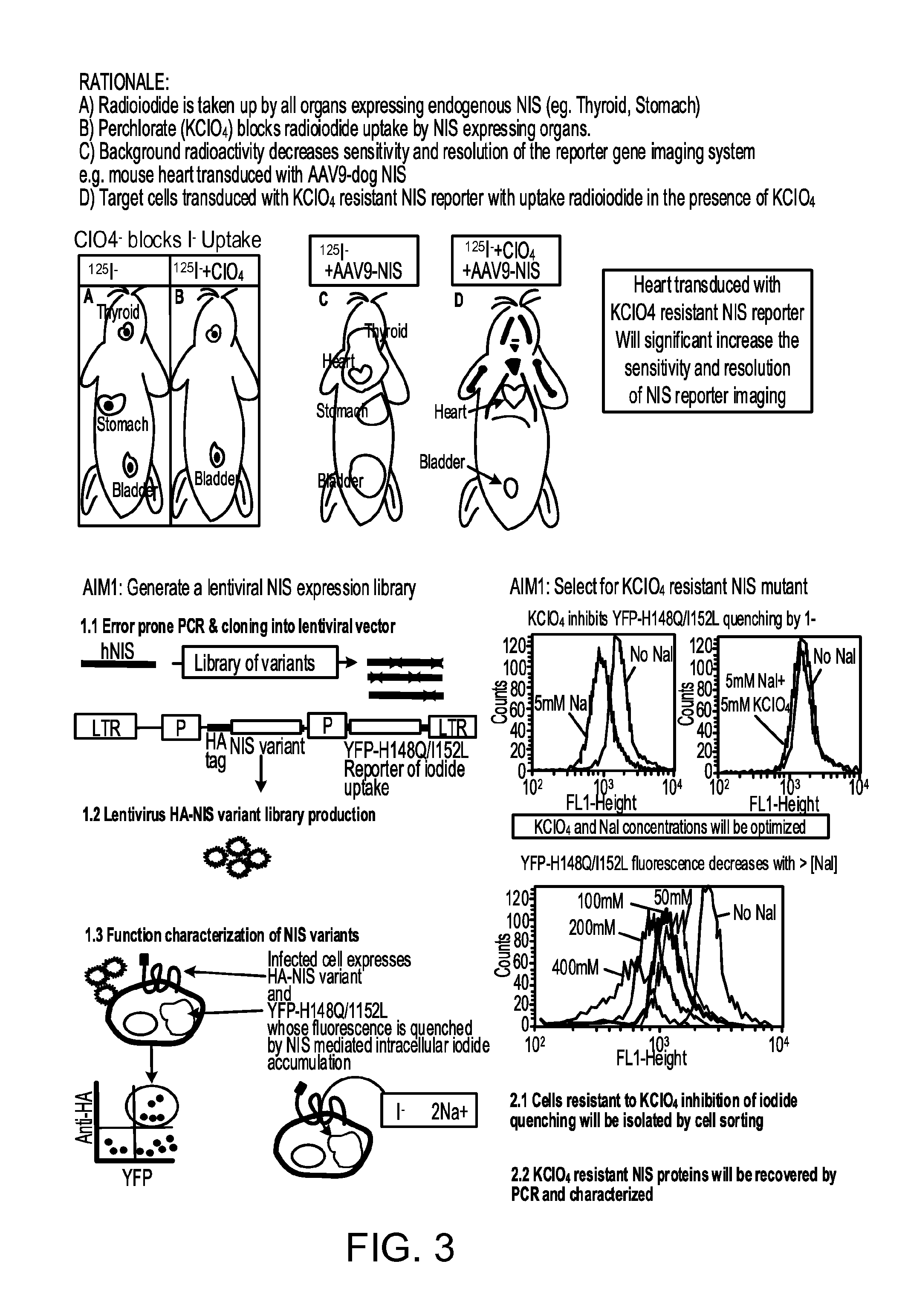Radiotracer imaging using sodium iodide symporter polypeptides
a radiotracer and sodium iodide technology, applied in the field of radiotracer imaging, can solve the problems of reducing the sensitivity of the nis reporter gene imaging system, sensitivity can be severely compromised, and it is difficult to define, detect, or pinpoint other nis polypeptide-positive cells in the surrounding area, so as to increase the detection sensitivity and resolution of radiotracers, and reduce background signals
- Summary
- Abstract
- Description
- Claims
- Application Information
AI Technical Summary
Benefits of technology
Problems solved by technology
Method used
Image
Examples
example 1
Selective Radiotracer Uptake by a Mutant NIS Polypeptide
[0057]Mel624 cells stably expressing a wild-type human NIS polypeptide (Mel-NIS) or one of two mutant NIS polypeptides (Mel-NIS-93E or Mel-NIS-93Q) were plated in 96-well plates at a density that would lead them to confluency on the day of the uptake assay. 1×Hank's balanced salt solution with calcium, magnesium (HBSS) (Cellgro) and 1 mM HEPES was adjusted to pH 7.3 using KOH (HBBS-HEPES) on the day of the assay. Culture medium was removed from the cells, and 150 μL of HBSS-HEPES+ / −300 μM KClO4 was added to the wells. The cells were incubated for 10 minutes at room temperature prior to the addition of radiotracer. Radiotracers, 125I and 99mTc, were diluted in HBSS-HEPES to about 70,000 to 100,000 CPM / 25 μL (CPM, counts per minute). 25 μL of radiotracer was added to the cells in HBSS-HEPES+ / −KClO4, and the cells were incubated at 37° C. for 1 hour. The cells were then washed twice with cold HBSS-HEPES buffer and lysed to release...
example 2
In Vivo Subtractive Imaging of NIS93E Expressing Tumors to Remove Background Signals from Endogenous NIS Expression in Tissues
[0059]Image subtraction is used to discriminate a tumor that concentrates only one of two NIS isotopes from organs that concentrate both isotopes (e.g., thyroid gland, stomach, and salivary glands). BxPC3 cells (human pancreatic tumor cells) stably expressing either wild-type human NIS polypeptides or human mutant NIS-93E polypeptides are implanted subcutaneously in the flanks of athymic mice. Once tumors grow to a diameter of 5-8 mm, 123I / 99mTc subtraction SPECT is performed using a dual-detector SPECT camera. Four hours after the intraperitoneal administration of 250 μCi 123I sodium iodide and 250 μCi 99mTcO4, SPECT / CT data are acquired. The SPECT emission data are collected in dual-energy windows to separate the 99mTc and 123I counts. The 99mTc window is centered at 140 keV, and the 123I window is placed with a 4% offset above 159 keV to minimize the spill...
example 3
Ingesting Oral CT Contrast Agents Removes Background Signals from the Stomach
[0061]Ingesting oral CT contrast agents (e.g., barium sulfate) removed background signals from the stomach as a result of NIS polypeptide-mediated uptake of radioisotopes, thus enhancing the quality of NIS imaging. In the following example, ingestion of barium sulfate was used to enable and enhance discrimination of NIS expression in the liver. The stomach endogenously expresses wild-type NIS polypeptides and uptakes radioisotopes such as radioiodine or pertechnetate, making the stomach highly visible in planar γ-camera, SPECT, or PET images. The strong stomach signal makes it difficult to define, detect, or pinpoint other NIS-positive cells in the surrounding area (e.g., the liver, perigastric area, pancreas, spleen, kidneys, or pleural space). However, a mouse fed barium sulfate by gavage and then imaged subsequently exhibited reduced isotope signals from the stomach and revealed positive isotope uptake b...
PUM
| Property | Measurement | Unit |
|---|---|---|
| pH | aaaaa | aaaaa |
| diameter | aaaaa | aaaaa |
| diameter | aaaaa | aaaaa |
Abstract
Description
Claims
Application Information
 Login to View More
Login to View More - R&D
- Intellectual Property
- Life Sciences
- Materials
- Tech Scout
- Unparalleled Data Quality
- Higher Quality Content
- 60% Fewer Hallucinations
Browse by: Latest US Patents, China's latest patents, Technical Efficacy Thesaurus, Application Domain, Technology Topic, Popular Technical Reports.
© 2025 PatSnap. All rights reserved.Legal|Privacy policy|Modern Slavery Act Transparency Statement|Sitemap|About US| Contact US: help@patsnap.com



